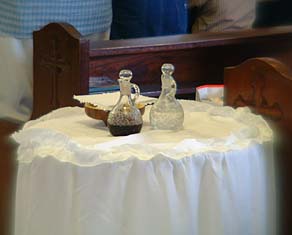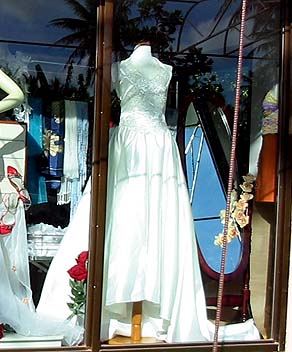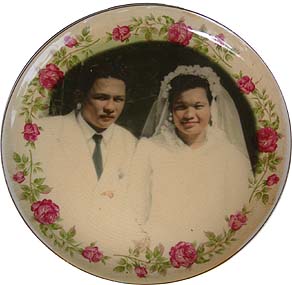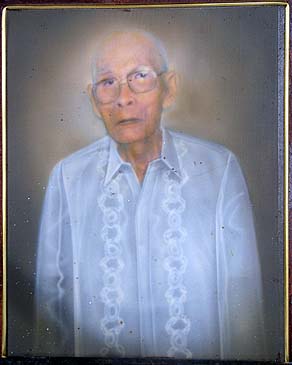 |
 |
 |
|||||
|
|
|
|
|
|
|
|
|
|
|
|||||||
|
|
|
|

|
|
“Our weddings are elaborate,” Ben says. “I remember that if you were to marry a local Tanapag girl, that the man would come and ask permission to talk to the lady, and the parents of that lady will tell the man how long he can stay. Sometimes they give him what they call plasu, it’s a time frame for the man to bring his parents to ask permission for marriage. It’s a Spanish word. And sometimes they give them five years, two years, and then this man who wants to marry this lady would bring either his godfather, mother, father, uncle, all those influential members of the family would come and sit down with influential family members of the bride-to-be, and discuss the marriage of the couple. "That’s very influential in the Chamorro custom. The Carolinians don’t do that. As a matter of fact, in my understanding, Carolinians didn’t get married per se, they just stayed together and had children. The Chamorros go through this ritual, a very rigorous ritual."
|
||
|
|
||
“The dowry , which we call a’ok, comes into the picture. The man’s family would pledge cows, they would pledge pigs. And usually the man’s family would buy the wedding gown. Including the wedding ring. There are times when both of them would contribute for their party, and I tell you this is a big party. They invite almost all of the people in the village. "But everybody helps also. The whole village. Some family members from other villages in the island, they would be there, too, and everybody helps. But it’s not like the fiesta where the entire island’s invited. This is only members of the family, relatives, cousins out there somewhere."
|
|
|
“The party sometimes last three days. They have what they call the ‘night of the bride,’ called Komplimentu, and then the wedding and then thereafter more food for visitors from abroad or visitors from the other villages. There’s a lot of tuba. Tuba is the coconut toddy, the fermented one, and people get pretty drunk. That’s pretty much it. Things simmer down. "The wedding ceremony was very unique in my upbringing. I find it to be a very interesting cultural practice. I didn’t know at that time, of course, that it was Spanish influence on our culture. "Now it has changed tremendously. Now you get married, you go to church then you go to hotel. I don’t enjoy that anymore."
|
|
|
|
“According to our custom, when they know that I have a boyfriend, I cannot talk to him outside the house,” Estella explains. “He has to come inside the house and sit with me in the house, and while we are talking my mother would sit beside me. And you know you cannot do anything when your mom is sitting right beside you! “During my time, when my husband came to ask permission for marriage, he brought his parents with him and his parents and our parents talk together. And then that’s when they set the time. They allowed time for me to get better because I was sick. So after I finished all of my medicine and I got better, that’s when they all came back again to ask when will be the marriage day.
|
||
|
|
||
“That’s the time that they set the date for us to go to see the priest. During that time you cannot marry right away. You have to wait for three calls at the church.” “They make an announcement in church,” Ben adds, “that Stella and Migeul are getting married. ‘This is the second call.’ They make a public announcement.” “Three times they make public announcements for us,” Estella continues. “That means three Sundays. We have to wait for three Sundays, and then the last one would be on Saturday, that’s the wedding, the wedding day. That’s called fandångo.”
|
|
|
“And the clothing: the mother of my husband, she took me to go to the Sister’s Convent to prepare for my clothes, my wedding clothes. I had to have three kinds of clothes: one for Komplimentu, one for wedding in the morning, and for the afternoon another dress. “The color for my dress for Confession is blue and then the color for my Komplimentu is a light purple. And then the color of my wedding dress is white, and we have to use the crown and veil. And the color of my afternoon dress is pink. My husband wears the coat and tie. "The night before we get married in the morning, there’s the Komplimentu. So the family, my husband’s family, brings drinks and beers and things for the Komplimentu, and when we have the Komplimentu there’s a band."
|
|
|
|
|
“The Komplimentu is a party before the fandångo, the wedding. At the last call, his parents will come with one bull cart of cutting wood, fine cutting wood. They bring also some things for cooking like rice, flour, everything that we have to cook they bring. They bring beer, soft drinks and all those things are for drinking that night. And they even bring one pig and they start hitting the pig to cry when they are coming to the house."
|
||
|
|
||
“And then they make us sit in the middle of the place and my god-mother will sit with me, and my husband and his god-father will sit together. Before they come for the Komplimentu the god-father should go in and ask for my hand to come out for the Komplimentu. And then he takes me out and makes me and my god-mother sit, and my husband will come and sit with me and his god-father. "Then there’ll be music: sometimes my relatives will sing and his relatives will answer back. That they call chamorrita. They will sing and my family will sing and they will answer; or if they sing, my family will answer their songs. During that time they play music like guitars, and somebody will be singing and everybody will be dancing."
|
|
|
"This was in this church here at Tanapag. This church was nearly built and we were the first ones to get married in this church. My brother Greg was the first one, and then I followed because Greg married in February and then I married in August. "The next day, the groom comes and picks us up at our house and we walk to the church. We walk to the church, my family and his family. We walk to the church and one of his family starts playing guitar while we are walking to the church. "And then when we go inside the church, we just stand at the back, and then the priest comes and takes us inside. Then after the ceremony, we go back to my house, all of us go back to my house. "My parents are already there, sitting down, and we have to kneel down and kiss their hands. Each of them, we have to go and kiss their hands. And my husband will follow me so that way he knows who are my aunties and my uncles."
|
"If your mother or your father passed away, then they have to wait, the breakfast will have to wait, because you have to go and visit the grave of your mother or your father. But in my case, my father and my mother were still alive and my husband’s father and mother were still alive, so we just went to my house and then we kissed their hands. "Then after we kiss our family, we go down to his family and we do the same. Then after that, my family will follow us because that’s the custom: if we go down, one of us will go down and start inviting the family of the groom because the first one to prepare the breakfast should be the bride. "So they invite all of the groom’s side. They come to our place and we have breakfast. Then when we finish breakfast, they take me inside and I change for the afternoon. So after I finish changing, the people from the groom’s side come over and invite us to go down for lunch."
|
|
|
|
|
"There’s a lot of crying," Estella says.
|
||
|
|
||
|
|
|
|
|
|

|
| Tanapag Home | Map Library | Site Map | Pacific Worlds Home |
|
|
|
|

|
|
|
|||
| Copyright 2003 Pacific Worlds & Associates • Usage Policy • Webmaster |
|||









